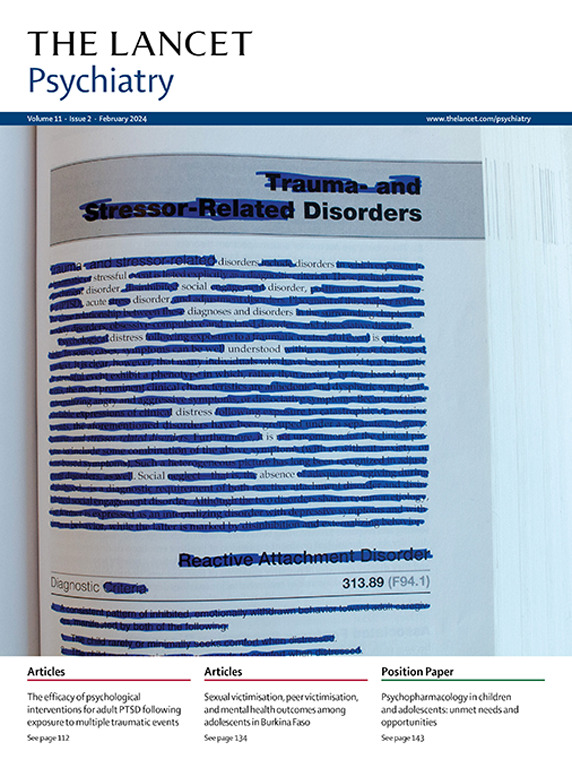抗 NMDAR 抗体血清检测呈阳性的精神分裂症谱系障碍患者的临床症状和社会心理功能:与检测呈阴性的患者进行病例对照比较。
IF 30.8
1区 医学
Q1 PSYCHIATRY
引用次数: 0
摘要
背景在精神分裂症谱系障碍(精神分裂症)患者的血清中发现了针对N-甲基-D-天冬氨酸受体(NMDAR)的抗体。然而,这些抗体在精神分裂症中的流行程度和临床意义尚不清楚。这一知识空白包括这些抗体可能与不同的临床特征相关,从而可能需要不同的治疗方法。我们的目的是评估抗 NMDAR 抗体在精神分裂症中的血清流行率,并比较血清阳性和血清阴性精神分裂症患者的症状和社会心理功能。方法在这次病例对照比较中,我们结合了新的和现有的研究,纳入了来自四个独立队列的精神分裂症患者,这些患者的抗 NMDAR 血清状态已通过活细胞检测进行了评估(或我们可以进行评估)。纳入的队列来自 EULAST 研究(一项在 15 个欧洲国家和以色列进行的试验)、OPTiMiSE 研究(一项在欧洲进行的干预性研究)以及 PPiP1 和 PPiP2 研究(在英国进行)。如果这些队列中的患者有完整的阳性和阴性综合征量表(PANSS)数据,则对其进行分析。没有参与者被诊断患有自身免疫性脑炎或接受过相关治疗。在计算血清中抗 NMDAR 抗体的流行率后,我们研究了抗 NMDAR 血清阳性患者与抗 NMDAR 血清阴性患者在 PANSS 评分(阴性、阳性、一般症状分量表和总分)上可能存在的差异。此外,还比较了以个人社会表现(PSP)评分衡量的心理社会功能。所有分析均为探索性分析,未进行多重检验调整。我们收集了四个队列中 1114 名精神分裂症患者的个人数据。研究对象的平均年龄为 28-6 岁(SD 7-6),其中女性 382 人(34-3%),男性 732 人(65-7%),包括白人(929 [83-4%])、亚裔(54 [4-8%])、黑人(68 [6-1%])和其他种族(62 [5-6%])患者。总体而言,41 名参与者(3-7%)(各组群的范围为 3-1-4-0%)的血清抗 NMDAR 抗体检测呈阳性。在阴性症状 PANSS 分量表中,抗 NMDAR 血清阳性患者的症状严重程度(平均分 15-8 [SD 6-4])低于抗 NMDAR 阴性患者(18-2 [6-8];科恩氏 d=0-36;p=0-026),以及一般症状 PANSS 分量表(32-9 [8-9] vs 36-1 [10-1];d=0-33;p=0-029)和 PANSS 总分(65-5 [18-5] vs 72-6 [19-3];d=0-37;p=0-013)。抗 NMDAR 阳性患者的 PSP 平均得分(62-0 [17-0])优于抗 NMDAR 阴性患者(53-5 [16-3];d=0-52;p=0-014)。因此,尽管研究结果有待在其他地区的队列中复制,但血清中的抗 NMDAR 抗体可能与不同形式的精神病有关。这些发现可为未来的预后和干预研究提供参考,这些研究将探讨抗NMDAR抗体是否与特定病程或治疗反应有关。本文章由计算机程序翻译,如有差异,请以英文原文为准。
Clinical symptoms and psychosocial functioning in patients with schizophrenia spectrum disorders testing seropositive for anti-NMDAR antibodies: a case-control comparison with patients testing negative.
BACKGROUND
Antibodies against the N-methyl-D-aspartate receptor (NMDAR) have been described in the serum of people with schizophrenia spectrum disorders (schizophrenia). However, the prevalence and clinical relevance of these antibodies in schizophrenia is unclear. This knowledge gap includes the possibility of such antibodies being associated with a distinct clinical profile, which in turn might warrant a distinct treatment approach. We aimed to assess the seroprevalence of anti-NMDAR antibodies in schizophrenia, and compare symptoms and psychosocial functioning between patients with schizophrenia who were seropositive and seronegative for these antibodies.
METHODS
In this case-control comparison, by combining new and existing studies, we included patients diagnosed with schizophrenia from four independent cohorts for whom anti-NMDAR serostatus had been assessed (or could be assessed by us) with live cell-based assays. Included cohorts were from the EULAST study (a trial conducted across 15 European countries and Israel), the OPTiMiSE study (an interventional study in Europe), and the PPiP1 and PPiP2 studies (conducted in the UK). Patients from these cohorts were analysed if they had complete Positive and Negative Syndrome Scale (PANSS) data. No participant had been diagnosed with autoimmune encephalitis or received treatment for this condition. After calculating the prevalence of serum anti-NMDAR antibodies, we examined possible differences in PANSS scores (negative, positive, and general symptom subscales, and total score) between anti-NMDAR-seropositive and anti-NMDAR-seronegative patients. Psychosocial functioning as measured by Personal Social Performance (PSP) score was also compared. All analyses were exploratory and no adjustment was done for multiple testing. People with lived experience were not involved in the conduct of this study.
FINDINGS
We collected individual patient data from 1114 patients with schizophrenia across the four cohorts. The study population had a mean age of 28·6 years (SD 7·6) and comprised 382 (34·3%) women and 732 (65·7%) men, including patients of White (929 [83·4%]), Asian (54 [4·8%]), Black (68 [6·1%]), and other (62 [5·6%]) ethnicities. Overall, 41 (3·7%) participants (range 3·1-4·0% across cohorts) tested positive for serum anti-NMDAR antibodies. Lower symptom severity on the negative symptoms PANSS subscale was observed for anti-NMDAR-seropositive patients (mean score 15·8 [SD 6·4]) than for anti-NMDAR-seronegative patients (18·2 [6·8]; Cohen's d=0·36; p=0·026), as well as on the general symptoms PANSS subscale (32·9 [8·9] vs 36·1 [10·1]; d=0·33; p=0·029) and total PANSS score (65·5 [18·5] vs 72·6 [19·3]; d=0·37; p=0·013). Mean PSP score was better in anti-NMDAR-positive patients (62·0 [17·0]) than in anti-NMDAR-negative patients (53·5 [16·3]; d=0·52; p=0·014).
INTERPRETATION
Serum NMDAR antibodies are present in 3-4% of patients with schizophrenia and are associated with relatively low severity of negative symptoms and relatively good psychosocial functioning. Thus, although the findings await replication in cohorts from other geographical regions, serum anti-NMDAR antibodies might be associated with a different form of psychotic illness. These findings could inform future prognostic and interventional studies examining whether anti-NMDAR antibodies are associated with a specific course of illness or with treatment response.
FUNDING
None.
求助全文
通过发布文献求助,成功后即可免费获取论文全文。
去求助
来源期刊

Lancet Psychiatry
PSYCHIATRY-
CiteScore
58.30
自引率
0.90%
发文量
0
期刊介绍:
The Lancet Psychiatry is a globally renowned and trusted resource for groundbreaking research in the field of psychiatry. We specialize in publishing original studies that contribute to transforming and shedding light on important aspects of psychiatric practice. Our comprehensive coverage extends to diverse topics including psychopharmacology, psychotherapy, and psychosocial approaches that address psychiatric disorders throughout the lifespan. We aim to channel innovative treatments and examine the biological research that forms the foundation of such advancements. Our journal also explores novel service delivery methods and promotes fresh perspectives on mental illness, emphasizing the significant contributions of social psychiatry.
 求助内容:
求助内容: 应助结果提醒方式:
应助结果提醒方式:


